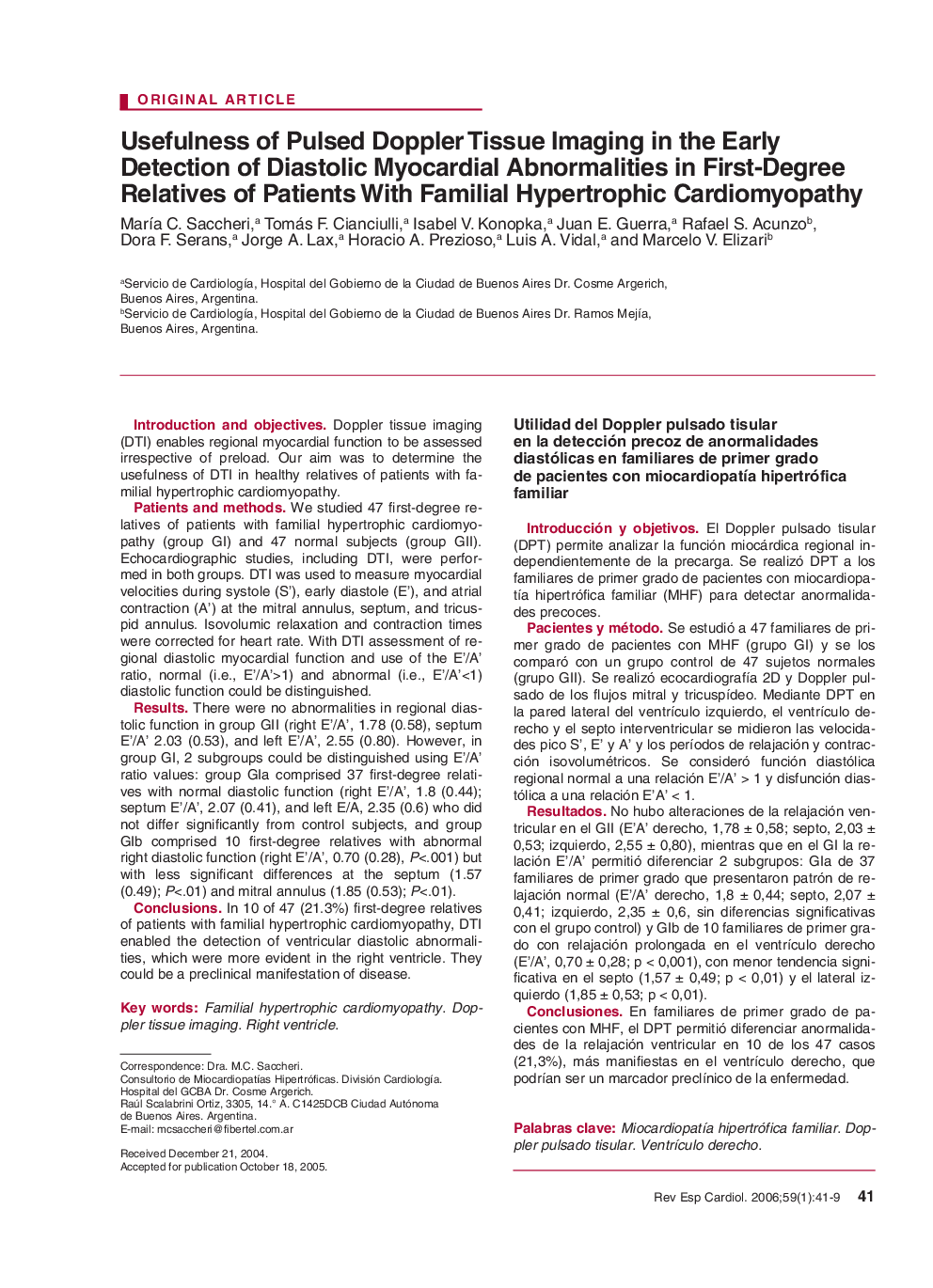| کد مقاله | کد نشریه | سال انتشار | مقاله انگلیسی | نسخه تمام متن |
|---|---|---|---|---|
| 3017899 | 1182137 | 2006 | 9 صفحه PDF | دانلود رایگان |

Introduction and objectivesDoppler tissue imaging (DTI) enables regional myocardial function to be assessed irrespective of preload. Our aim was to determine the usefulness of DTI in healthy relatives of patients with familial hypertrophic cardiomyopathy.Patients and methodsWe studied 47 first-degree relatives of patients with familial hypertrophic cardiomyopathy (group GI) and 47 normal subjects (group GII). Echocardiographic studies, including DTI, were performed in both groups. DTI was used to measure myocardial velocities during systole (S'), early diastole (E'), and atrial contraction (A') at the mitral annulus, septum, and tricuspid annulus. Isovolumic relaxation and contraction times were corrected for heart rate. With DTI assessment of regional diastolic myocardial function and use of the E'/A' ratio, normal (i.e., E'/A' > 1) and abnormal (i.e., E'/A' < 1) diastolic function could be distinguished.ResultsThere were no abnormalities in regional diastolic function in group GII (right E'/A', 1.78 (0.58), septum E'/A' 2.03 (0.53), and left E'/A', 2.55 (0.80). However, in group GI, 2 subgroups could be distinguished using E'/A' ratio values: group GIa comprised 37 first-degree relatives with normal diastolic function (right E'/A', 1.8 (0.44); septum E'/A', 2.07 (0.41), and left E/A, 2.35 (0.6) who did not differ significantly from control subjects, and group GIb comprised 10 first-degree relatives with abnormal right diastolic function (right E'/A', 0.70 (0.28), p <.001) but with less significant differences at the septum (1.57 (0.49); P <.01) and mitral annulus (1.85 (0.53); P <.01).ConclusionsIn 10 of 47 (21.3%) first-degree relatives of patients with familial hypertrophic cardiomyopathy, DTI enabled the detection of ventricular diastolic abnormalities, which were more evident in the right ventricle. They could be a preclinical manifestation of disease.
Introducción y objetivosEl Doppler pulsado tisular (DPT) permite analizar la función miocárdica regional independientemente de la precarga. Se realizó DPT a los familiares de primer grado de pacientes con miocardiopatía hipertrófica familiar (MHF) para detectar anormalidades precoces.Pacientes y métodoSe estudió a 47 familiares de primer grado de pacientes con MHF (grupo GI) y se los comparó con un grupo control de 47 sujetos normales (grupo GII). Se realizó ecocardiografía 2D y Doppler pulsado de los flujos mitral y tricuspídeo. Mediante DPT en la pared lateral del ventrículo izquierdo, el ventrículo derecho y el septo interventricular se midieron las velocidades pico S', E' y A' y los períodos de relajación y contracción isovolumétricos. Se consideró función diastólica regional normal a una relación E'/A' > 1 y disfunción diastólica a una relación E'A' < 1.ResultadosNo hubo alteraciones de la relajación ventricular en el GII (E'A' derecho, 1,78 plusmn; 0,58; septo, 2,03 plusmn; 0,53; izquierdo, 2,55 plusmn; 0,80), mientras que en el GI la relación E'/A' permitió diferenciar 2 subgrupos: GIa de 37 familiares de primer grado que presentaron patrón de relajación normal (E'/A' derecho, 1,8 plusmn; 0,44; septo, 2,07 plusmn; 0,41; izquierdo, 2,35 plusmn; 0,6, sin diferencias significativas con el grupo control) y GIb de 10 familiares de primer grado con relajación prolongada en el ventrículo derecho (E'/A', 0,70 plusmn; 0,28; p < 0,001), con menor tendencia significativa en el septo (1,57 plusmn; 0,49; p < 0,01) y el lateral izquierdo (1,85 plusmn; 0,53; p < 0,01).ConclusionesEn familiares de primer grado de pacientes con MHF, el DPT permitió diferenciar anormalidades de la relajación ventricular en 10 de los 47 casos (21,3%), más manifiestas en el ventrículo derecho, que podrían ser un marcador preclínico de la enfermedad.
Journal: Revista Española de Cardiología (English Edition) - Volume 59, Issue 1, January 2006, Pages 41-49